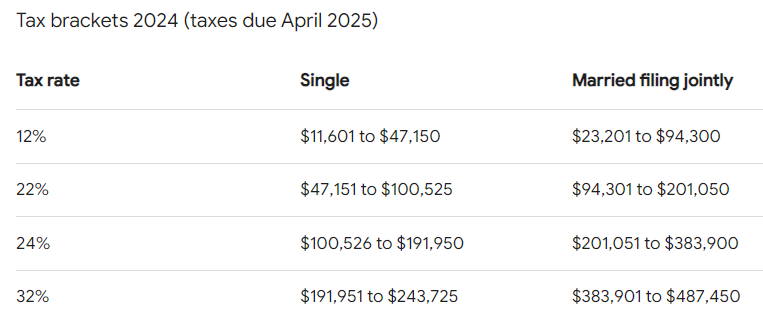Worry Free Tax and Accounting is constantly keeping up with changes made to tax law and how that affects your tax return preparation. With all the recent tax law changes you need a professional in your corner who know the ins-and-outs of the ever changing field of tax law. We do our homework so you don’t have to.
2024 Tax Deadlines
The end of the 2024 tax season for most Americans is April 15, 2024. If you are unable to file before that date, you still have options.
- You can file for an extension. Filing an extension gives you an additional six months to October 15, 2024, to submit a complete return. If you believe you will owe taxes, you must estimate how much you owe and pay the amount due with your extension form.
- You can file a late return without an extension. If you do not owe taxes or you expect a refund, you may not owe a penalty. If you owe taxes, you may be charged a penalty for filing late.
- If you do not owe taxes or you expect a refund, you may not owe a penalty. Still, it may be best to file as soon as you can to receive your refund or to ensure you don’t owe a balance. See below for more information on ways to file a return for free and claiming your tax refund.
Stimulus Check
The U.S. federal government has approved the new $2600 stimulus checks in July 2024 for seniors. This stimulus check will be paid to those people who are of the age of 65 years or above, disabled, or blind.
IRS $600 Rule
Under the new rules set forth by the IRS, if you were paid more than $600 for the transaction of goods and services through third-party payment platforms, you will receive a 1099-K for reporting the income.
Medical Expense Deduction
Previous law: Taxpayers who itemize their taxes can deduct medical expenses that exceed 10 percent of their adjusted gross income, or AGI, according to the IRS.
New law: Taxpayers can deduct medical expenses that exceed 7.5 percent of AGI in 2017 and 2018, but the new deduction level ends January 1, 2019.
Standard Deduction
The standard deduction is the amount that you can deduct from your income before calculating your tax liability if you do not itemize your deductions.
Previous law: The standard deduction for married filing jointly would increase to $24,000 for joint filers; $12,000 for single taxpayers; and $18,000 for heads of households, according to the TPC analysis. The increased deduction ends after 2025.
New law: For tax year 2024, the standard deduction for married couples filing jointly rises to $29,200, an increase of $1,500 from 2023. For single taxpayers, the standard deduction rose to $14,600, a $750 increase from the previous year.
Personal Exemption
A personal exemption is the amount that you can deduct from your income for every taxpayer and most dependents claimed on your return.
Previous law: $4,050 per person, which means a married couple with two dependents would receive a personal exemption of $16,200.
New law: The personal exemption is eliminated. The exemption returns after 2025.
Child Tax Credit
Previous law: The credit would increase to up to $2,000 per child, and the first $1,400 would be refundable according to the TPC analysis, meaning the credit could reduce your tax liability below zero and you would still be able to receive a tax refund. The cut off for the tax credit would increase from $110,000 to $400,000 for married couples filing jointly. The expanded credit ends after 2025.
New law: For 2024 (taxes filed in 2025), the child tax credit will be worth $2,000 per qualifying dependent child if your MAGI is $400,000 or below (married filing jointly) or $200,000 or below (all other filers).
Mortgage Deductions
Previous law: Taxpayers who itemize their taxes can deduct interest payments on mortgage debt of up to $1.1 million. That includes up to $100,000 of home equity debt.
New law: For current mortgage holders, there is no change. But the deductible limit drops to $750,000 for new debt incurred after December 31, 2017. Also, homeowners may not claim a deduction for existing and new interest on home equity debt, beginning January 1, 2018. The mortgage deduction changes expire after 2025.
Medical Expense Deduction
Previous law: Taxpayers who itemize their taxes can deduct medical expenses that exceed 10 percent of their adjusted gross income, or AGI, according to the IRS.
New law: Taxpayers can deduct medical expenses that exceed 7.5 percent of AGI in 2017 and 2018, but the new deduction level ends Jan. 1, 2019.
Limits on Itemized Deductions
Previous law: Itemized deductions may be limited, and total itemized deductions may be phased out (reduced), if your adjusted gross income for 2017 exceeds $313,800 for married couples filing jointly or qualifying widows ($261,500 for single filers, $287,650 for heads of household and $156,900 for married couples filing separately), according to the IRS.
New law: Starting in calendar year 2023, the Inflation Reduction Act reinstates the Hazardous Substance Superfund financing rate for crude oil received at U.S. refineries, and petroleum products that entered into the United States for consumption, use, or warehousing. The tax rate is the sum of the Hazardous Substance Superfund rate and the Oil Spill Liability Trust Fund financing rate. For calendar years beginning in 2024, the Hazardous Substance Superfund financing rate is adjusted for inflation. For calendar year 2024 crude oil or petroleum products entered after Dec. 31, 2016, will have a tax rate of $0.26 cents a barrel. Read more…
Inflation Rate Measure
Previous law: The IRS uses the Consumer Price Index for urban consumers to adjust tax bracket thresholds and other tax provisions for inflation. That includes such provisions as the standard deduction, the personal exemption, earned income tax credit and the alternative minimum tax, as the Tax Policy Center explains.
New law: The IRS would switch to an inflation index known as the chained CPI. As we have written, chained CPI is considered a more accurate measure, but rises somewhat more slowly than the traditional CPI. That would mean bracket thresholds and tax credits, for example, would rise more slowly. That could have the effect over time of pushing more people into higher tax brackets and reducing the purchasing power of tax credits.
Capital Gains Tax Rate
Capital gains are the profits realized from the sale of assets such as stocks or real estate.
Previous law: The profits on the sale of assets held for more than one year are eligible for a tax break. Turbo Tax explains the 2017 tax rates this way for the profits gained from the sale of such assets: “For 2017, the long-term capital gains tax rates are 0, 15, and 20 percent for most taxpayers. If your ordinary tax rate is already less than 15 percent, you could qualify for the zero percent long-term capital gains rate. For high-income taxpayers, the capital gains rate could save as much as 19.6 percent off the ordinary income rate.”
New law: No changes.
Pass-Through Business Taxes
Previous law: Businesses organized as sole proprietorships, LLCs and partnerships don’t pay corporate tax rates. Instead, the owners pay individual income taxes on their share of business income — they’re called pass-through business taxes. Those tax rates are the same as the individual income tax rates.
New law: Business owners can take a 20 percent deduction on their pass-through business income, with limits for those earning above $157,500 (single) and $315,000 (married, filing jointly).




